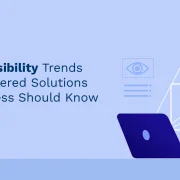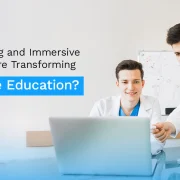
Top 7 Blended Learning Resources for Workforce Training and Development
Summary
Discover the top resources for implementing blended learning in workforce training, focusing on tools and strategies that enhance employee development and performance.
Blended learning is a revolutionary and highly efficient workforce training and development approach that combines traditional classroom instruction with online and digital learning.
This training method can help organizations provide a more flexible and cost-effective training solution that caters to the individual needs of each employee. This is a win-win situation for the employees and the organization as a whole.
This article will explore the top blended learning resources for workforce training and development that you can use today.
Top 7 Blended Learning Resources to Consider Today
Here are the top seven to note if you are looking for the best resources to upskill your workforce.
1. Learning Management Systems (LMS)
A Learning Management System (LMS) is a software platform that provides all the online training and course management tools you need in one convenient location. It allows learners to access training materials, complete assignments, and take assessments at their own pace.
An LMS can also be used to track progress and generate reports. The benefits of using an LMS for workforce training include flexibility, cost-effectiveness, and easy monitoring of learner progress.
One of the drawbacks of LMS is that it may only be suitable for some types of training, particularly hands-on training that requires practical skills.
Additionally, some learners may need assistance with the self-directed nature of LMS training, which means more support from trainers. This can be counterproductive in certain scenarios.
2. Microlearning
Microlearning is another modern blended learning resource that involves breaking down complex concepts into small, easily digestible chunks of information.
This approach is particularly suited for workforce training as it allows employees who are usually short of time to focus on specific skills and areas they need to improve as and when they get some time.
Microlearning resources can include short videos, podcasts, infographics, and quizzes. The benefits of microlearning for workforce training include
- increased engagement and motivation,
- personalized learning, and
- cost-effectiveness.
However, one of the drawbacks of microlearning is that it may only be suitable for some types of training, particularly those that require more in-depth knowledge and skill development.
Additionally, microlearning can be challenging to create. Organizations may need to invest in developing high-quality microlearning resources feasible for organizations with a limited budget for training.
3. Gamification
Gamification is a blended learning resource is gaining much traction in recent years. It primarily involves using game-based elements such as a point-based system or leaderboards to get employees hooked on achieving specific learning goals while providing an enhanced learning experience.
Learning via Gamification can be particularly effective for workforce training. Its addictive nature can increase employee engagement, motivation, and retention without making it just another task or a learning goal.
Gamification can be used in various training contexts, from compliance to product training.
However, one of the drawbacks of Gamification is that it may only be suitable for some types of training, particularly those that require more practical skills development. Additionally, it can be challenging to implement effectively, and organizations may need to invest in designing high-quality game-based learning resources.
4. Virtual Reality (VR) and Augmented Reality (AR)
Virtual Reality (VR) and Augmented Reality (AR) are blended learning resources using advanced digital technology and equipment to provide immersive and practical training.
These technologies can be particularly effective for workforce training where the practical application of what is being taught is the priority, as they can simulate real-world environments and situations.
This can be particularly useful in scenarios where safety is a priority. VR and AR can be used in various training contexts, from safety training to skills development.
However, one of the drawbacks of VR and AR is that they may only be suitable for some types of training, particularly those that require a significant investment in technology and resources.
Additionally, VR and AR can be challenging to implement effectively unless organizations have the funds to invest in the equipment needed to implement this form of training effectively.
5. Social Learning
Social learning involves using social media and similar learning platforms to provide a better learning experience. It is safe to say that almost everyone is on social media and is addicted to it to a certain extent.
This approach takes advantage of this, resulting in an effective blended earning resource for workforce training. This form of learning allows learners to share knowledge and best practices and take ownership of learning.
Social learning can be used in various training contexts, from compliance to product training. The benefits of social learning, when used in the context of workforce training, include increased engagement, motivation, and learning retention.
However, one of the drawbacks of social learning is that it may only be suitable for some types of training, particularly those that require more individualized attention and feedback.
Additionally, social learning can be challenging to manage, and organizations may need to invest in establishing clear guidelines and protocols for learners to follow.
6. Personalized Learning Paths
Personalized learning paths involve tailoring the training experience to the individual needs of each employee. This approach can be efficient for workforce training as it allows employees to focus on the skills and knowledge areas they need to improve.
In addition, data analytics, assessments, and learner feedback can create personalized learning paths based on the caliber of each employee.
The benefits of personalized learning paths for workforce training include increased engagement, motivation, and retention of learning.
Customized learning paths do have their own sets of limitations as well. They can be challenging to implement if the organization does not have the required workforce or the training budget to implement this.
7. Instructor-Led Training
Instructor-led training is a tried and tested form of training that has been used for years. It can be a particularly effective tool for workforce training when combined with online digital learning resources to supplement the instructor’s training.
This form of training allows employees to interact with trainers and fellow employees, ask questions, and receive immediate feedback. At the same time, it allows access to online material to clear any doubts or learn certain topics in more detail.
Instructor-led training can be used in various contexts, from soft to technical skills training.
Summing It Up
There are several blended learning resources and approaches for workforce training and development. By combining traditional classroom instruction with online and digital learning, organizations can provide a training solution that is
- flexible,
- cost-effective,
- personalized, and
- caters to the individual needs of each employee.
When choosing a blended learning approach, organizations should consider the specific needs of their workforce and the training goals they wish to achieve. They also need to consider the costs involved when choosing a particular learning method.
By selecting the right resources and strategies, organizations can ensure that their workforce receives the best possible training and development to boost individual learning and the overall production of the organization.
If you’re seeking to craft captivating blended learning courses, then HURIX Digital is the go-to choice. Our E-learning and training solutions rank among the finest in the industry. We deliver efficient and engaging solutions customized to your specific needs.
So connect with us today if you are looking to improve your workforce training game.

Senior Vice President
Julia brings over 20 years of global experience in digital learning and business strategy. She specializes in client success, enterprise learning solutions, and driving growth through innovation, with a focus on AI, VR, and emerging technologies across diverse industry verticals.




